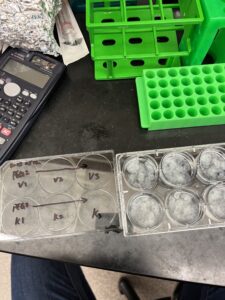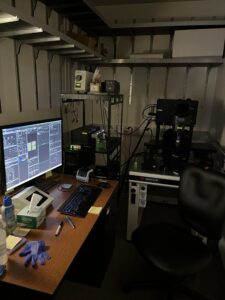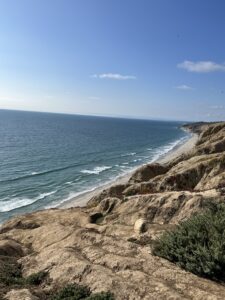Hello everyone! My name is Melaina Yender and I’m spending six weeks studying neuroscience and click chemistry at the Ye Lab at Scripps Research Institute in San Diego, California. I have been given the wonderful opportunity of working with Cailynn Wang and Zhengyuan (Ben) Pang who are my mentors for this summer. The work my mentors conduct is tracing hallucinogenic drugs in brain tissue through a process called clearing-assisted tissue click chemistry (CATCH) which is the process of clearing the lipids of the cells in brain tissue slices to make them transparent while also maintaining the cellular structure of the cells. This allows for the tissues to be imaged more clearly and the drug targets can be identified with greater ease. The drugs are able to be traced in the brain through the attachment of fluorescent tags to the drug molecules which can then be seen under a confocal laser scanning microscope. This is important as the lab can then trace where drugs go in the brain and learn if they are binding to their intended targets. Many drugs do not have high specificity and will not always bind to their targeted receptors, but rather to surrounding receptors which leads to adverse side effects. Understanding this is crucial to the development of drugs for clinical applications and the understanding of drug binding in the brain. The development of click chemistry by a scientist at Scripps was awarded a Nobel Prize in Chemistry in 2022, and I am extremely honored to be working with this astounding chemical process that will provide a larger insight into drugs binding in the brain.
For the first week of my internship, I learned a lot about the CATCH process as a whole. On my first day, I was given the chance to select a specific slice of brain tissue from four different mice that were injected with Salvinorin A Pretreatment and the vehicle which is the control. These tissues already went through most of the clearing process before I arrived, so I helped with the ending process for the tissues which was creating an overnight buffer solution that would initiate the labeling of the drug. The following day I helped to create another buffer solution but this was what initiated the click reaction. The tissues were placed in the reaction buffer for an hour and were then incubated in diluted DAPI staining which finished the click process. The tissues were then able to be imaged using confocal laser microscopy and the drugs were able to be seen in the
brain tissues. After the imaging, the process was able to be repeated for a different kind of technique that used different kinds of drugs. The CATCH process is limited to covalent drugs which create irreversible bonds to the receptors in the brain because reversible drugs don’t last in the brain as they are needed to be for the process. So they started a brand new technique in the lab that uses electric chemistry to change the binding of the drugs to the receptors to become irreversible and can further be identified and visualized.
This was a major as my mentors have not done this previously and it has not been attempted for this kind of work and with click chemistry. For this process, I observed the harvesting of multiple brains from mice including multiple perfusions that clear the blood from the brain and fix it using PFA. I also had the opportunity to use the vibratome machine which slices the tissues at a thickness of 100 microns (0.1 mm), which is similar to that of paper. Once sliced, the tissues are able to be cleared and the CATCH process can be applied. Throughout this week, I’ve been given many papers to read about different drugs including Salvinorin A and Ketamine. I learned about how they bind to receptors in the brain and how the specificity of a drug is crucial to its effects. I’ve enjoyed learning more about the function of these hallucinogens and their effects on the brain. In my spare time there I also practiced my pipetting skills and mounted slides with different tissues.
I have been very grateful to have my internship placed in San Diego as I have never been to California before. I’ve had multiple opportunities to go to the beach and see the ocean as I am staying less than five miles away from it! I am living in an Airbnb with four other Pinhead interns and a host mom, and it has been wonderful going to different places with them and working in the same lab with Natalie and Lily.
This week was an amazing start to my six weeks, and I am greatly looking forward to this coming week!




Melaina, you wrote this so visually that one who is not familiar with the work can understand the process. Sounds like a fantastic start to your internship!
Way to go Mel!! This is amazing! I am so proud of you. This is amazing work.
Melaina, this was a great blog, super interesting and informative. Your pictures are captivating and the research you are doing sounds super important and interesting. Keep up the great work!
Wow, Melaina!!! You blow me away with all this crazy science! It’s so cool what you’re doing, and I think you’re going to go on to do truly amazing things!!! <3
Wow what an amazing opportunity. Even though I am not totally understanding everything you are saying I love imagining you in the lab. We continue to pray for you every day. Love you! Nana